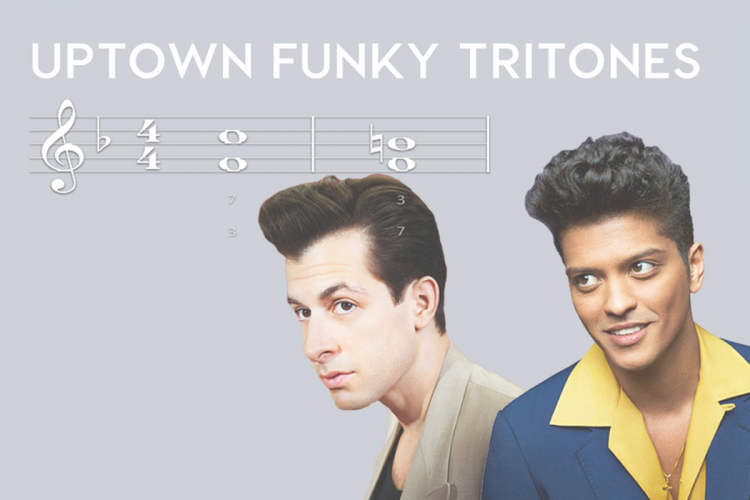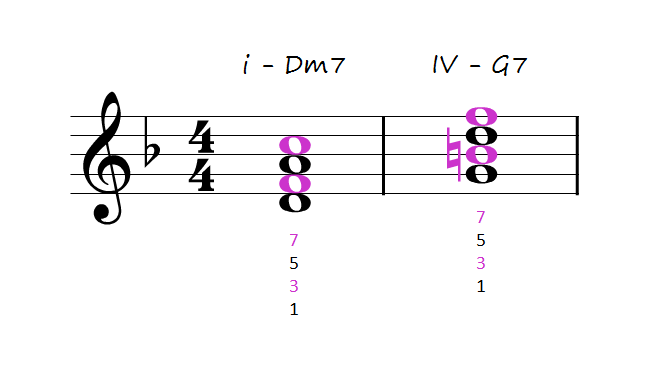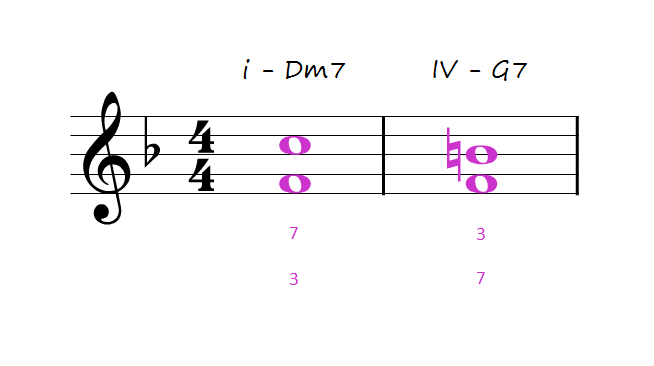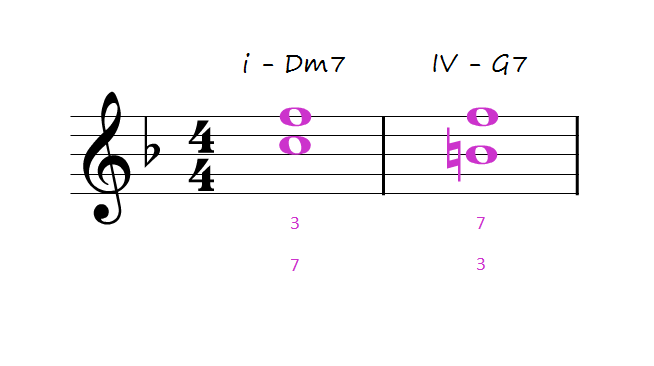
“Perfect – fourth / Perfect – fourth / Tri – tone / Tri – tone”
“Perfect – fourth / Perfect – fourth / Tri – tone / Tri – tone”
Can you hear it in your head? If you did, you’re funky enough — go do something else, smarty. If not, feel free to help me take a look at how Mark Ronson and Bruno Mars’ smash hit “Uptown Funk” uses a “Funk i-IV 3-7 Tritone Flip.” We’ll learn what that is exactly, where it comes from, and also some other tunes that have put this funky tonal trick to work for them. For now, here’s what those intervals sounds like in the song, about 8 seconds in:
+ Welcome to Soundfly! We help curious musicians meet their goals with creative online courses. Whatever you want to learn, whenever you need to learn it. Subscribe now to start learning on the ’Fly.
What Is the Funk i-IV 3-7 Tritone Flip?
The funk i-IV 3-7 tritone flip is when you play the 3rd and 7th chord degrees of a minor one-seven chord type (i7), followed by the 3rd and 7th chord tones of a major four-seven chord type (IV7).
Here are what those chords look like in D minor (“Uptown Funk”’s key.) The 3rds and 7ths have been colored in purple (and they should really be sixteenth notes instead of whole notes, but more on that later). Listen to how that sounds on a keyboard below: 
Get Funky
Next, to make it all tight and funky, you toss out the 1s and 5s, then “flip” one of these 3-7 intervals.
Below is the flip, or inversion, of the IV (G7) chord’s 7th chord tone. By lowering it an octave, it now matches up with the 3rd chord tone of the minor one-seven chord (Dm7.)

When it comes to how this is commonly heard in funk, it doesn’t really matter which “3-7” you flip — people do it both ways. Above, I flipped the G7’s 3 and 7. But I really only chose that way because it fits more nicely on the staff and the unison is in the bass, which I think looks a little better.
In the song “Uptown Funk,” the guitar riff flips it the other way, so it starts with an inversion. The unison interval is on top so that the tritone is approached from a perfect 4th (P4), rather than a perfect 5th (P5) interval. Here’s what that looks like:

I should take this opportunity to mention that you don’t necessarily have to flip the 3-7. Plenty of funk riffs that highlight just the 3’s and 7’s of i’s and IV’s leave the chords as they are without inversion flips.
What Makes It Funk?
Okay, but here’s the thing: You can play these intervals in any kind of music, right? So then, what ties what we’re doing here to the funk genre, specifically? First off, in most other genres, minor keys use minor four chords (iv) way more often than major four chords (IV).
Do you see that B natural in the above graphic? In most other genres, that would be a B flat like the key signature says it should be! Show me that raised 6th in a minor key on any staff, and I’d put my money on it being a funk tune every time.
Another way of thinking about it is to go a step further and say that it’s the key signature that’s wrong. Let’s say that we should just straight up change the key signature to line up with the loop’s natural 6th, and then describe the music as being in the Dorian mode. But then some people don’t like that, because if you still have leading tones and blue notes in there, what’s the point? And do we really need a bunch of jerks at the clubs saying stuff like “Well, actually, this is in a Dorian blues key.” We’re wasting good dance party time, let’s move on.
Let’s get back to what makes this i-IV 3-7 flip specific to funk. It’s about drawing contrasts. In a large number of funk tunes, the tritone is found in the major IV7 chord, as opposed to finding it in, say, the V or I. This stands in contrast to most other genres, where the tritone is featured more often in the V7; or, in a ton of heavy metal and rock hits, where it’s heard with the tonic, making flat 5 chords. Examples of tritone I♭5 rock/metal flavors can be heard in “Purple Haze,” “Smoke on Water,” “Enter Sandman,” “Kashmir,” and “Wake Up.”
What About the Blues?
In addition, some of you may be wondering by now: “Dude, what about the blues genres? Those are genres where you hear the tritone in the I, IV, and the V, because they all have dominant 7s with tritones.” That’s a good question. But in “Uptown Funk” and many other funk tunes, it’s that the tritone is featured much more often in the IV7 — not the V7, I♭5, or I7. Below is what this all looks like on the staff. We’ll stay in the key of D, but I’ll have to switch the key signature to major, because that’s where V7 and I7 are found more often (tritones are in green).

To clarify, it’s not that funk tunes can’t use these chords — many do. It’s just a matter of higher instances of IV7s in funk. For instance, “Uptown Funk” doesn’t even have a major I or a V you could put a 3-7 tritone in, even if you wanted too.
Lastly, and probably more importantly, what makes our featured riff a funk riff and not a blues, metal, or rock riff is its rhythm.
Genre-Specific Rhythmic Subdivisions
Rock and metal songs are mostly based on rhythms with duple subdivisions, often written as eight notes. Blues and blues-rock songs are mostly based on rhythms with triplet subdivisions, written as “swung” or “shuffled” eights, or as triplets. Finally, funk songs are mostly based on quadruplet subdivisions, written as 16th notes.

16th notes are one thing, but it’s the accents and syncopations in the these quadruplet subdivisions where funk really separates itself from the pack!
(PS: Of yet, if you were wondering, there have been no music genres based on quintuplets. Why? Because that would be pretty insane. I mean, maybe robot musicians of the future will figure out how to create and sustain a genre with quintuplet subdivisions. But for now, quadruplets is where we leave it.)
To close, below is a playlist of some other songs that employ Dorian-esque minor one (i) to major four (IV) quadruplet funky flavors:
- “Brick House” by the Commodores
- “Flashlight” by Parliament
- “Shake Your Pants” by Cameo
- “If You Have to Ask” by the Red Hot Chili Peppers
- “Shake” by The Gap Band
- “Funky Kingston” by Toots & The Maytals (Which has a 3-5/7-3 tritone guitar riff for i to IV)
- “Chameleon” by Herbie Hancock
- “Pick up the Pieces” by Average White Band
- “She’s a Bad Mama Jama (She’s Built, She’s Stacked)” by Carl Carlton
- “Right Place Wrong Time” by Dr. John
- “Get On Up – Part One” by James Brown (Listen for the piano, around a minute in.)
- “Stomp” by the Brothers Johnson
Here’s some homework: With a little key transposition and rhythmic modification, take the guitar riff from “Uptown Funk” and see if you can make it fit with any or all of these other examples. For extra credit, see if you can find any more perfect interval (P4 or P5) to tritone flips caused by the i-IV chord change. The only passing grade for this assignment will be an F… for funk.
Show us what you’ve found in the comments below!
Want to get all of Soundfly’s premium online courses for a low monthly cost?
Subscribe to get unlimited access to all of our course content, an invitation to join our members-only Slack community forum, exclusive perks from partner brands, and massive discounts on personalized mentor sessions for guided learning. Learn what you want, whenever you want, with total freedom.



